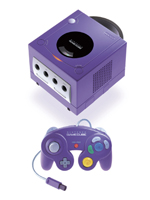
 |
|
Nintendo officially announces GAMECUBE[08.24.00] » Check out the GIA's extensive details and first-hand impressions straight from the press conference floor: controllers, memory cards, demos, online capability, release dates, software announcements, and more. Nintendo officially announced their next generation system today, the Nintendo GAMECUBE, and the GIA's J.T. Kauffman was there to relay the details and give his own impressions. The console is noteworthy first for its size and unique design - at anywhere from one-half to one-third the size of the PlayStation 2, GAMECUBE's design itself lives up to the name by being 4.3 by 6 by 6 inches, or 150 mm wide, 110mm high, and 161 mm deep. There will be five different colored consoles available at launch. The console will use a proprietary optical disc media co-designed by Matsushita (known as Panasonic in the U.S.), and Nintendo made repeated mentions of the extensive steps against piracy this unique format would make. Each 8cm wide disc has a 1.5 gigabyte capacity, and due to the size of these discs and the system itself, any rumors of DVD movie capabilities can be considered officially dead. There were three sets of tech demos shown with the system, each taking advantage of familiar characters. The first set consisted of non-interactive real-time footage of various Nintendo characters, beginning with Luigi sliding down a bannister while being persued by Boos, followed by a crowd-pleasing scene of Link and Ganon fighting, multiple X-Wings flying through space, and a shot of Samus Aran running down a corridor which "brought down the house." These initial demos were "very well put together," and the the visual quality "definitely surpassed that of the PlayStation 2" at first look. Next came the true star of the show, as Shigeru Miyamoto brought the world its first glimpse of Mario on the GAMECUBE. Miyamoto first introduced the classic 8-bit Mario while the camera zoomed in until each of his distinctive pixels was a large block. Mario's 64-bit incarnation was up next, lifting each of these blocks to reveal yet another 64-bit Mario, continuing until there were a full 128 of the 64-bit Marios were on screen at once. Filters and effects were instantly applied to the demo, including cel shading, motion blur, transparencies, and even warping the landscapes themselves. A bar at at the bottom of the screen designed to show CPU usage barely touched a third, and Miyamoto made a point of telling the crowd that each of the Marios was being individually processed, as could be seen in their unique behavior, rolling and jumping over each other with aplomb. Nintendo's most popular franchise of the moment was saved for last, as "Meowth's Party" rounded out the series of three demos. A 3D Meowth began singing, soon followed by a troupe of dancing Squirtles and increasingly more and more Pokémon until anywhere from 75-100 3D versions of the characters filled the screen. Each character model was slighty better than the quality of those found in the N64's Pokémon Stadium, and the assistant playing the game moved the camera freely around the environment. The controller itself is a strange creation at first glance, resembling a meld of Sony's Dual Shock and Nintendo's own three-pronged N64 controller, sans middle prong. It contains internal force feedback behind the center of the controller, and has no expansion slots. Instead, the two memory card slots are located beneath the system's four face controller ports, and will hold 4 Mb "Digicards." Nintendo also said that an SD format similar to Sony's memory sticks can be used, providing 64 Mb of storage for input devices such as digital cameras. The GAMECUBE controller itself is larger than a Dual Shock, and replaces the latter's left analog stick with a digital pad and promises to use the right analog stick to perform the functions of the C buttons on an N64 controller. The 4 action buttons to the side are designed to focus on the A button, and Miyamoto commented that he wanted games that could be played simply by someone picking up the controler and pushing the A button. To the left of the blue A button is the classic green B button, with grey X and Y buttons above and to the right respectively. The shoulder buttons resemble an the Dual Shock's 4 shoulder buttons, but with analog for L2 and R2, a digital R1, and an omitted L1. Nintendo presenters joked that they had solved the problems which plagued the Dreamcast controller's analog functions, and also showed off a quick CAD demo of the controller's build. Those of you used to Sega's VMUs giving your controller a screen will have a new option: plugging your Game Boy Advance directly into the GAMECUBE for use as a standard controller. Miyamoto commented on the advantages of a full color screen for use in things such as football games. Another first will be in-house developed wireless controllers, a project termed "Wavebird" by Nintendo. They promise a range of over 30 feet (10m), and prototypes were actually used by Nintendo staffers for the demos themselves, demonstrating an impressive range. Lastly, the online capabilities of the system were announced, with both dial-up and broadband adapters promised. The GAMECUBE features a bay underneath where either can be inserted, but whether these will be packed in at launch or not remains unclear. The first official games for the system will be shown at next May's Electronic Entertainment Expo, as the tech demos shown today were just that, and have not been confirmed as games. The system is set for a July 2001 release in Japan with a "minimum of 5 launch titles" of an undisclosed nature, with an October 2001 release to follow in the U.S. Look for further details over the next few days as Space World 2000 continues.
|
|
|||||||||||||||||||||
